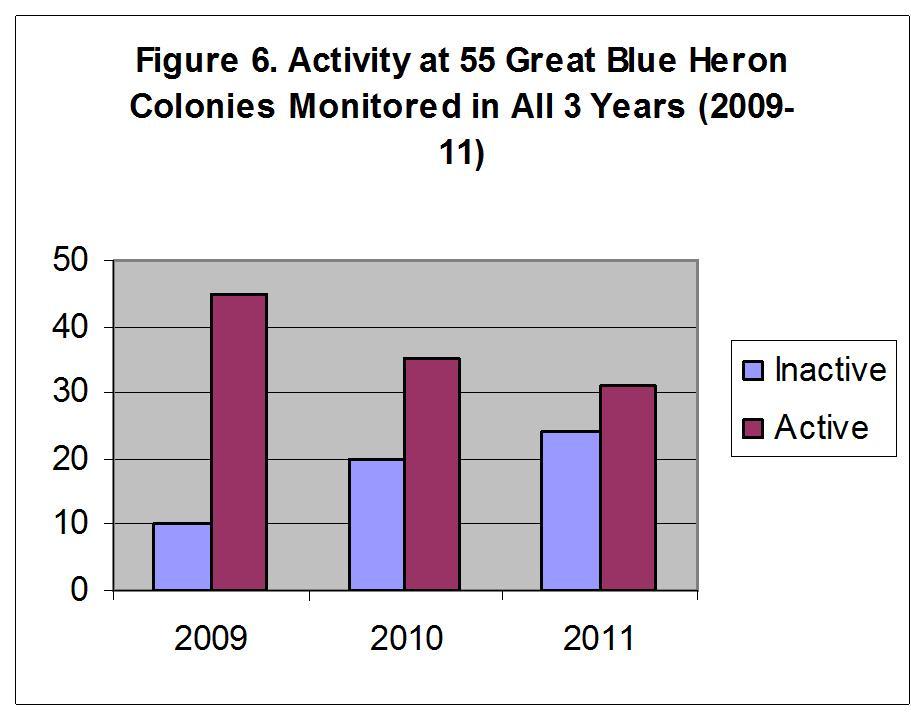January 27, 2012 at 4:36 pm
Introduction
Since 2007, the great blue heron (Ardea herodias) has been listed inMaine as a Species of Special Concern. While this status has no regulatory significance, is does signify possible decline and that more information is necessary to accurately determine the population trend. Thus, an effort was initiated in 2009 to better track great blue heron colonies and the number of nesting pairs in the state, both on coastal islands and at inland sites.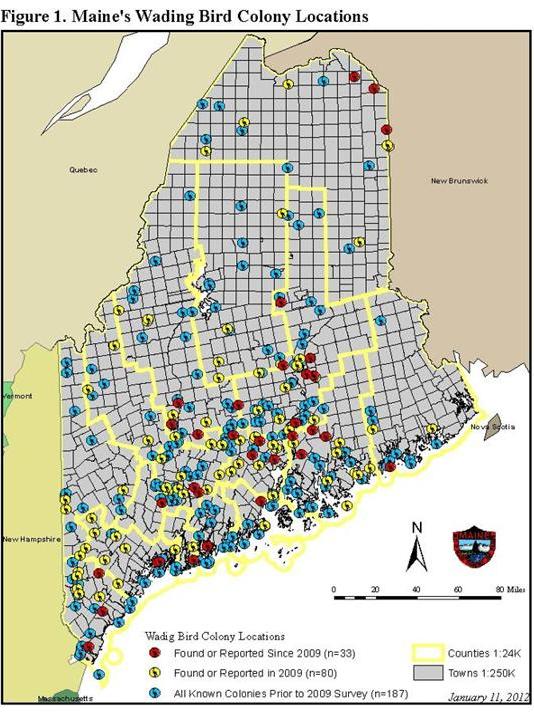 In 2009, MDIFW conducted a nearly statewide census of all colonial wading birds, with emphasis on the great blue heron. With the help of pilots from the Warden Service and Forest Service, biologists conducted over 60 hours of aerial surveys. Over 180 historical locations were checked, and 80 new sites were discovered during the surveys or as a result of information provided by the public or other biologists (Figure 1). In addition to aerial surveys, biologists visited 38 colony sites on the ground to help verify colony locations and to gather more precise counts of active nests. Survey efforts revealed 1,071 nesting pairs of great blue herons at 83 colonies. Since 2009, 33 additional colonies have been discovered or reported to MDIFW (Figure 1).
Aerial surveys are the most efficient way to assess great blue heron colony activity on a large scale. Unfortunately, they are also expensive and MDIFW does not have the financial means to collect this level of data on an annual basis. In order to continue building our knowledge of wading bird colonies inMaineover time, MDIFW began a volunteer colony monitoring program in 2009 called the Heron Observation Network, or HERON for short. HERON volunteers monitor colonies by visiting known current or historic nesting locations at least once during the breeding season and recording the species, number of nests active and inactive, and in some cases the number of nestlings or fledglings.
In 2009, 45 HERON volunteers signed up to monitor 66 colonies. Twenty of these volunteers ended up following through with their commitment and turned in observation data for 28 colonies. Of those that turned in data, 15 also tracked and reported the amount of time they committed, totaling 186 hours.
In 2009, MDIFW conducted a nearly statewide census of all colonial wading birds, with emphasis on the great blue heron. With the help of pilots from the Warden Service and Forest Service, biologists conducted over 60 hours of aerial surveys. Over 180 historical locations were checked, and 80 new sites were discovered during the surveys or as a result of information provided by the public or other biologists (Figure 1). In addition to aerial surveys, biologists visited 38 colony sites on the ground to help verify colony locations and to gather more precise counts of active nests. Survey efforts revealed 1,071 nesting pairs of great blue herons at 83 colonies. Since 2009, 33 additional colonies have been discovered or reported to MDIFW (Figure 1).
Aerial surveys are the most efficient way to assess great blue heron colony activity on a large scale. Unfortunately, they are also expensive and MDIFW does not have the financial means to collect this level of data on an annual basis. In order to continue building our knowledge of wading bird colonies inMaineover time, MDIFW began a volunteer colony monitoring program in 2009 called the Heron Observation Network, or HERON for short. HERON volunteers monitor colonies by visiting known current or historic nesting locations at least once during the breeding season and recording the species, number of nests active and inactive, and in some cases the number of nestlings or fledglings.
In 2009, 45 HERON volunteers signed up to monitor 66 colonies. Twenty of these volunteers ended up following through with their commitment and turned in observation data for 28 colonies. Of those that turned in data, 15 also tracked and reported the amount of time they committed, totaling 186 hours.
2010 Survey and Monitoring Efforts
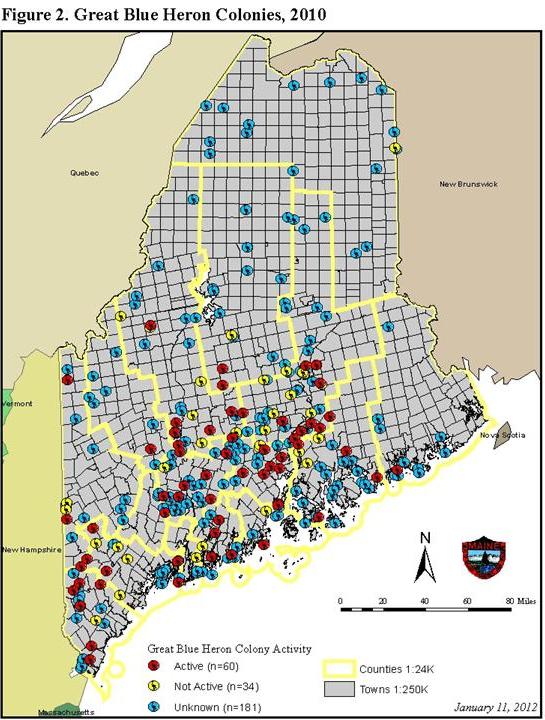 Survey and monitoring efforts in 2010 consisted of biologists and volunteers monitoring 94 great blue heron colonies, of which 60 were active with approximately 898 pairs (Figure 2). The Heron Observation Network grew in 2010: 64 volunteers signed up to monitor 80 colonies; 42 volunteers turned in observation data for 52 colonies; and 22 volunteers recorded 148.5 hours. In spite of this growth, there were 19 colonies that had been active in 2009 that did not get surveyed in 2010 due to lack of sufficient staff time, volunteers, or funding for aerial surveys; thus it is unknown whether or not these colonies were active in 2010.
Survey and monitoring efforts in 2010 consisted of biologists and volunteers monitoring 94 great blue heron colonies, of which 60 were active with approximately 898 pairs (Figure 2). The Heron Observation Network grew in 2010: 64 volunteers signed up to monitor 80 colonies; 42 volunteers turned in observation data for 52 colonies; and 22 volunteers recorded 148.5 hours. In spite of this growth, there were 19 colonies that had been active in 2009 that did not get surveyed in 2010 due to lack of sufficient staff time, volunteers, or funding for aerial surveys; thus it is unknown whether or not these colonies were active in 2010.
2011 Survey and Monitoring Efforts
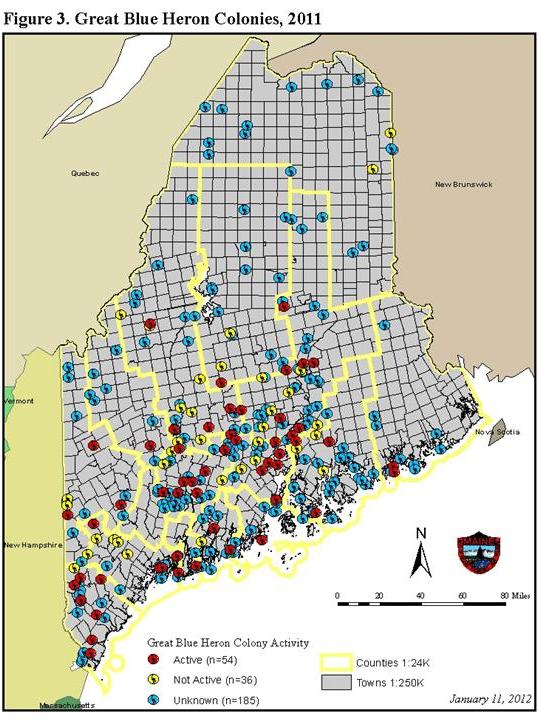 During the 2011 breeding season, biologists and volunteers monitored 90 great blue heron colonies, of which 54 were active with approximately 783 pairs (Figure 3). Thirty-four colonies containing 77 nests were also monitored but did not show nesting activity. HERON continued to grow in 2011 with 76 volunteers who signed up to monitor 111 colonies; 50 volunteers who turned in observation data for 75 colonies; and 28 volunteers who recorded 255 hours. Even with this amount of effort, there were 31 out of 100 great blue heron colonies that were active in 2009 and/or 2010 that did not get surveyed in 2011 due to lack of sufficient staff time, volunteers, or funding for aerial surveys.
During the 2011 breeding season, biologists and volunteers monitored 90 great blue heron colonies, of which 54 were active with approximately 783 pairs (Figure 3). Thirty-four colonies containing 77 nests were also monitored but did not show nesting activity. HERON continued to grow in 2011 with 76 volunteers who signed up to monitor 111 colonies; 50 volunteers who turned in observation data for 75 colonies; and 28 volunteers who recorded 255 hours. Even with this amount of effort, there were 31 out of 100 great blue heron colonies that were active in 2009 and/or 2010 that did not get surveyed in 2011 due to lack of sufficient staff time, volunteers, or funding for aerial surveys.
Importance of Volunteers
In three years, the HERON program has grown significantly and has provided “free” data that will be used to assess the population trend for Maine’s great blue herons (Figures 4 and 5). An additional benefit of this program has been the use of volunteer time as a match for federal funding such as State Wildlife Grants (SWG). These federal funds often require a non-federal match ratio of 50:50. Volunteer time that is properly tracked and recorded is assigned an hourly rate of worth, is included in the full cost of the project, and is counted as in-kind match for the funds needs to support survey and monitoring efforts such as aerial surveys and vehicles for on the ground work by biologists and contractors.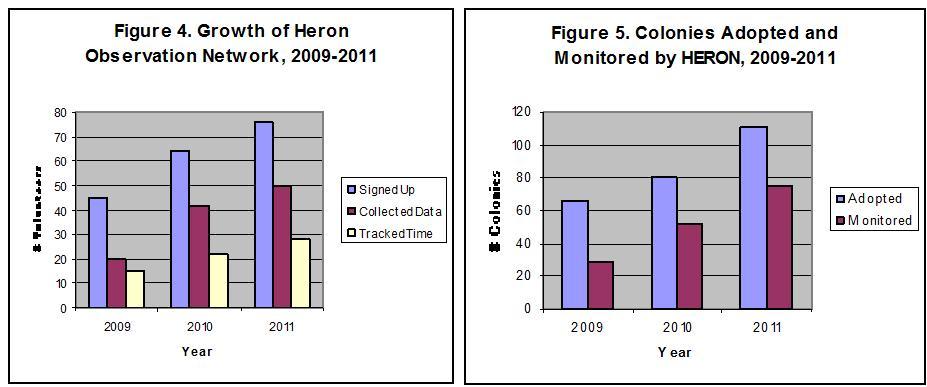 Volunteer time will also be used this winter and spring as a match for SWG funds to hire a contractor to enter data into MDIFW’s ETSC (Endangered, Threatened and Special Concern) database and GIS. We hope to use volunteer time as a match for funding an aerial survey in 2015.
Volunteer time will also be used this winter and spring as a match for SWG funds to hire a contractor to enter data into MDIFW’s ETSC (Endangered, Threatened and Special Concern) database and GIS. We hope to use volunteer time as a match for funding an aerial survey in 2015.
Initial Trend
The 2010 and 2011 field seasons did not cover all known colonies across the state, thus we cannot determine a statewide population trend at this time. However, there were 55 colonies that were monitored each of the three years (2009, 2010, and 2011), and colony occupation among the 55 sites declined by 26% (Figure 6). It is unknown if this decline is simply an artifact of herons changing their colony locations, or if it is an indication of a true decline in nesting activity. This cannot be determined without complete knowledge of all colonies across the state or another method for estimating the nesting population of great blue herons.Survey for Estimating Statewide Population
It may never be possible to survey the entire state for nesting great blue herons in one year because they occupy such a wide variety of habitats: snags in wetlands, live trees in uplands both adjacent to and far removed from lakes and wetlands, and coastal islands. Nearly the entire state of Maine is considered “potential nesting habitat”. For this reason, we are working on developing a survey that will sample the state and use known colony sites to develop a model for estimating the breeding population of great blue herons. This survey is planned for 2015.Between Now and 2015
Over the next three years, we hope to increase monitoring efforts across the state with the help of HERON volunteers. Every year, important colonies do not get monitored due to a lack of volunteers in the right parts of the state. In addition, we hope to learn of new colony locations to add to our database and future monitoring. A press release will be issued in early spring of each year to recruit new volunteers and to solicit new colony information. Many colonies do not get monitored due to volunteers who sign up to monitor a site but do not follow through. We hope to remedy this with more communication in the middle of the breeding season. If volunteers are unable to monitor the site they sign up for, they simply need to inform MDIFW so someone else can observe the colony before the end of the breeding season. Volunteer hours will continue to be tracked and recorded by those who complete the necessary paperwork, and will be used to help leverage funds for the planned survey in 2015. The HERON blog (http://maineheron.wordpress.com) and the HERON Facebook page (http://www.facebook.com/maineheron) will continue to serve as a means to communicate with and educate current volunteers, landowners, and the public. We plan to increase postings to the blog and Facebook and encourage interactive dialogue through these media in the coming years.Categories

